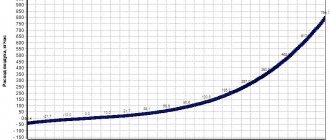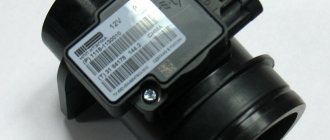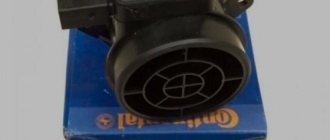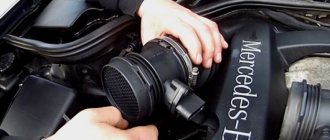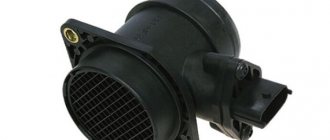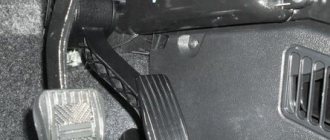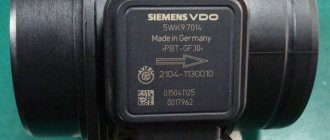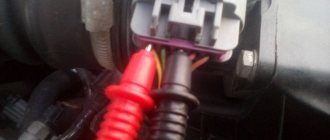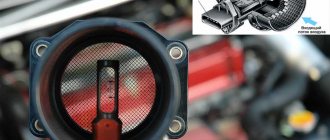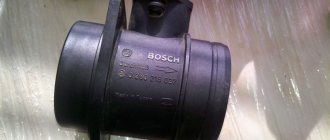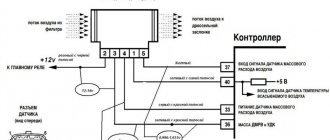The Bosch 116 mass air flow sensor or mass air flow sensor is a regulator designed to control the volume of air that enters the engine. This controller is one of the elements of electronic engine control systems with fuel injection. In this article we will try to answer the question of how models 116 and 037 differ.
Characteristic
On VAZ cars, the mass air flow sensor is mounted between the air filter element and the throttle hose. Today, products from the manufacturer Bosch are very popular among compatriots. Regardless of whether it is a universal Bosch sensor or, for example, spark plugs, quality from a German manufacturer can always give a head start to domestic products. Let's look at the main characteristics of regulators models 116 and 037.
DMRV 116 is designed to control and convert the air flow that enters the motor into voltage. The data transmitted by the regulator makes it possible to determine the operating mode of the power unit and calculate the cyclic filling of the cylinders with air flow. This filling is carried out in steady-state operating modes of the motor, which last no more than 0.1 seconds.
Let's look at the technical features that Bosch 0 280 218 116 has:
- the regulator operates on the principle of measuring air flow;
- the device provides accurate data, which ensures optimal fuel consumption;
- operating range varies from 8 to 550 kg/h;
- the output pulse level when measuring the range from 0 to 100% will be about 0.05-5 volts;
- As for power supply, the controller is powered from the vehicle’s electrical network, that is, 12 volts is enough for it;
- current consumption is about 0.5 ampere;
- the regulator can function normally in the operating range from 45 degrees below zero to 120 degrees;
- The service life of the Bosch 116 mass air flow sensor is about 3 thousand hours.
As mentioned above, the technical features of the models are the same:
- the operating range for normal operation varies in the region of 8-550 kg/h;
- when operating correctly, the controller will provide accurate data, making it possible to achieve optimal gas mileage (of course, if the engine is running in normal mode);
- since the element is used in a car, it is logical that it should be powered by 12 volts;
- the controller consumes about 0.5 ampere of current;
- the part can operate normally both at 45 degrees below zero and at 120 degrees of heat, this is its operating range;
- service life is at least 3 thousand hours;
- unlike model 116, the new mass air flow sensor 037 during calculations can produce an error of 2.5 percent (both downward and upward).
Video “Features of replacing a flow meter in a garage”
How the replacement procedure is carried out and what points should be taken into account when performing this task - find out from the video below (author - channel In Sandro's Garage).
Did you like the article? Share with friends:You may also be interested inPower steering
Installation of the UAZ 417 distributor drive: order and ignition circuit, adjustment and configuration of the lock The UAZ distributor is considered one of the important components of the ignition system in a vehicle. Correct adjustment of this… Media devices
Operating instructions for Sony radio: all models, pinout and connection of the car radio Probably every person has heard about Sony at least once in their life. This brand has been producing equipment for many years... Security system
Car alarm STARLINE B9: installation and operating instructions (download in PDF format), connection diagram and key fob programming The Starline B9 manual includes installation recommendations, as well as diagrams necessary for proper connection... Ignition system
Procedure and ignition diagram for ZIL 130: instructions for installing and connecting a contactless system. A modern car is a complex system of components and mechanisms that must interact smoothly. Ignition system… Security system
Car alarm STARLINE A91: operating and installation instructions (download and read in PDF format), how to install auto start and typical connection diagram The Starline A91 security system, equipped with an automatic engine start module, provides reliable protection for cars
Adjustment and ignition order of the GAZ-53: how to set the marks, video of installing the distributor drive The ignition system plays an important role for the internal combustion engine. The timeliness and power of spark formation depends on the uninterrupted operation of the safety protection system.
Why does the ELM327 Bluetooth not connect to the ECU, there is no communication and connection with the unit, the adapter does not see it? The procedure for checking the performance of a car engine can be performed both visually and with the help of an additional
Replacing the Lada Granta alternator belt with air conditioning and its tensioner: how to remove, tension and change. Power to the vehicle's electrical equipment while driving is provided by a generator, which operates thanks to a belt drive.
What is the difference between sensors 037 and 116?
How can the regulators of these models differ from each other and is it possible to install 116 instead of 037? There are differences between these controllers, and the point is not in the MAF pinout. After all, if these models were the same, what would be the point of giving them different names?
So, how do the controllers differ from each other and is it possible to install model 116 instead of 037:
Replacement is allowed, but experts do not recommend this. This is because these devices differ in their calibration, so in case of replacement, you will have to change the parameters of the control unit. And you can only get into the “brains” of a car if you understand what needs to be done and have minimal experience.
The mass air flow sensor (MAF) is installed on modern cars with injection engines between the air filter and the air intake and is designed to estimate the amount of incoming air required to create a fuel-air mixture. This sensor is one of the most expensive sensors installed on a vehicle.
But, unfortunately, like other car equipment, it can fail.
If the mass air flow sensor is faulty, the “Check Engine” indicator turns on, and the readings of the faulty sensor are replaced by the controller with a fixed air temperature value of 33 degrees C.
Signs of a DMRV malfunction may include:
Before buying a new one, you should make sure that the sensor installed on the car is working. You can check the functionality of this sensor yourself; for this you will need a multimeter.
1. Check the voltage on the mass air flow sensor block:
The voltage at pin No. 2 should be at least 12 V, and at pin No. 4 about 5 V.
If the device readings are different, it means the battery is discharged, the power circuit or the computer is faulty.
2. How to check the Bosch mass air flow sensor (articles: 0 280 218 004, 0 280 218 037, 0 280 218 116):
Try to reach along the sensor connector wires without disturbing the insulation.
On the new device, the output voltage ranges from 0.996 to 1.01 V.
During operation, this voltage gradually increases and by its value you can find out about the wear of the mass fuel flow sensor:
- if the sensor is in good condition, the voltage is from 1.01 to 1.02 V;
- in satisfactory condition - from 1.02 to 1.03 V;
- the sensor resource ends if the voltage is in the range from 1.03 to 1.04 V;
- a value in the range from 1.04 to 1.05 indicates a near-death state; if there are no contraindications, then you can continue to use the sensor;
- if the voltage exceeds 1.05 V, the mass air flow sensor requires replacement.
Compare the device readings:
The voltage of the new mass air flow sensor is 0.996V -1.01V;
If the voltage is within 1.01 V-1.02 V, then the sensor is in good condition;
If the voltage is within 1.02 V-1.03 V, then the condition of the sensor is satisfactory, still working;
If the voltage is within 1.03 V-1.04 V, the sensor’s service life ends;
The voltage is in the range of 1.04 V - 1.05 V, then the condition of the sensor is critical, if there are no negative symptoms, it can be used for now, but it will soon need to be replaced;
If the voltage is 1.05 V or more, it's time to purchase a new sensor.
Dear customers, in order to avoid errors when sending the connecting connector to the mass air flow sensor (MAF), in the “Comment” line indicate which mass air flow sensor, your car model, year of manufacture and number of valves, engine size.
In different versions of fuel injection systems on VAZ vehicles, two types of mass air flow sensors (MAF) can be used. They differ in design and in the nature of the output signal, which can be frequency or analog. In the first case, the signal frequency changes depending on the air flow, and in the second case, the voltage changes. The ECU uses information from the mass air flow sensor to determine the duration of the injector opening pulse.
The BOSCH 225 (E-GAS) hot-wire mass air flow sensor is installed in a housing located between the air filter and the air supply hose to the throttle assembly. The M17.9.7 controller uses information from the mass air flow sensor to determine the duration of the injector opening pulse. The sensor uses three sensing elements. One element determines the air temperature, and the other two, connected in parallel, are heated to a certain temperature higher than the air temperature.
The air passing through the sensor cools the heated elements. The higher the air flow rate, the more intense the cooling. The sensor's electronic circuit determines air flow by measuring the electrical power required to maintain a given temperature of the heated elements. The sensor provides information about air flow in the form of a digital signal.
Connecting block 0280218225АХ with 5 contacts assembled with wires, is one of the elements of the controller harness, connects to the BOSCH mass air flow sensor 0 280 218 225 (E-GAS) in cars Lada Priora, Lada Granta, Kalina 2 and their modifications injector (16V ) with engine capacity 1.6L, (E-GAS), EURO-4. Can be used to make your own cable. The contacts are already crimped onto the wires (wire length 100 mm) and inserted into the connector according to the pinout, so they can be installed on the car.
Structurally Mass air flow sensor (MAF) BOSCH 225 (E-GAS) Art. 0 280 218 225 has a sensing element, a thin mesh (membrane) based on silicon, which is installed in the intake air flow. The grid contains a heating resistor and two temperature sensors, which are installed before and after the heating resistor.
If the sensor or its circuits fail, the engine management system malfunction indicator in the instrument cluster lights up, and the controller calculates the mass air flow value based on the crankshaft speed and throttle position.
The accelerator pedal position is transmitted to the engine control unit via two accelerator pedal position sensors (variable resistors), which are connected to the accelerator pedal.
The position of the VAZ 2170 accelerator pedal (depending on the driver’s actions) is the main input value for the engine control unit.
The throttle valve is driven by an electric motor (throttle servomotor) in the throttle valve control module, namely over the entire speed and load range.
The VAZ 21126 throttle valve is actuated by a servo drive according to signals from the engine control unit. With the engine off and the ignition on, the engine control unit controls the throttle servomotor, exactly matching the data from the accelerator pedal position sensor. This means that when the accelerator pedal of the VAZ 2170 is pressed halfway, the servo drive equally opens the throttle valve; in this case, the throttle valve will also be open approximately halfway.
When the engine is running (under load), the engine control unit can open and close the throttle valve, independent of the accelerator pedal position sensor.
So, for example, the throttle valve of a VAZ 21126 may already be fully open, although the accelerator pedal of a VAZ 2170 is only pressed halfway.
The advantage of this scheme is that throttling losses at the throttle valve are prevented.
In addition, at certain loads there are noticeably better emissions and fuel consumption figures.
Replacement of contact carrier 0280218225АХ assembled with wires, which is an element of the ignition system harness, connecting the BOSCH 225 mass air flow sensor (E-GAS) in cars Lada Kalina2, Lada Priora, Lada Granta and their modifications injector (16V) with an engine capacity of 1.6L, (E-GAS), EURO-4, can be done independently, without contacting specialized maintenance services.
The engine control unit, analyzing the required torque for various components (e.g. air conditioning, automatic transmission, ABS/ESP..), calculates the optimal throttle opening angle for a given situation.
Product Features:
The mass air flow sensor (catalog designation “BOSCH” 0280218225) is designed to convert the air flow entering the engine into DC voltage. The sensor information allows you to determine the engine operating mode and calculate the cyclic filling of the cylinders with air at steady engine operating conditions, the duration of which exceeds 0.1 seconds.
Based on the sensor signal, the ECU calculates the amount of air entering the engine cylinders. If the mass air flow sensor malfunctions, the electronic control unit switches the system to backup mode.
Other article numbers of the product and its analogues in the catalogs: 1928AO0152, 0280218225AX.
VAZ 1117-1119, VAZ 2170-2172, VAZ 2190, VAZ 2121-21214, VAZ 2123.
How to identify a problem with the BOSCH 225 (E-GAS) mass air flow sensor?
How to replace the BOSCH 225 (E-GAS) mass air flow sensor in a Lada Priora, Granta car yourself?
With the online store Discounter AvtoAzbuka, repair costs will be minimal.
Just COMPARE and BE SURE.
Don't forget to share the information you find with your friends and acquaintances, as they may also need it - just click one of the social networking buttons below.
Dear customers and visitors! Please note that we ship orders from the city of Tolyatti!
Before shipping, we will carefully check, carefully pack and quickly deliver to the Russian Post or to a transport company!
Happy shopping!
Dear visitors and customers, we would like to draw your attention to what methods can you pay for your orders?
Pay with any card on the website for ordering and delivery. There is also an option to pay only for the order - and pay for delivery upon receipt of the goods
Based on the signal from the mass air flow sensor (MAF), the cyclic filling of the cylinder is calculated, which is ultimately converted into the duration of the injector opening pulse. If it does not work correctly, the car consumes more gasoline than necessary. Such a sensor is installed on the second path, immediately behind the air filter and connected to the electrical system, which is controlled by a six-pin block of wires.
There are quite a few different types of mass air flow sensors: mechanical, ultrasonic, hot-wire and some others.
In this case, we will consider the design of the HFM-5 hot-wire sensor from Bosch, which is most often installed on VAZ cars. The sensor's sensitive element is a thin film on which several temperature sensors and a heating resistor are located. In the middle of the film there is a heating area, the degree of heating of which is controlled using a temperature sensor.
On the surface of the film, on the side of the air flow and on the opposite side, two more thermal sensors are located symmetrically, which record the same temperature in the absence of air flow. In the presence of air flow, the first sensor is cooled, and the temperature of the second remains unchanged, due to the heating of the air flow in the heater zone. The differential signal of both sensors is proportional to the mass of passing air.
The sensor's electronic circuit converts this signal into a constant voltage proportional to the air mass. This design is called Hot Film (HFM), its advantages include high measurement accuracy and the ability to record reverse air flow, but its disadvantages include low reliability in conditions of contamination and moisture.
To measure the amount of air that enters the engine means to determine the engine load. When the driver presses the gas pedal, the throttle valve opens and the amount of intake air increases. At the same time, we say that the load has increased. When you release the pedal, the load drops. It's quite simple. However, this is only at first glance. If we take into account the fact that in real driving conditions the engine often changes operating modes and the incoming air in the intake system participates in several gas-dynamic processes, then the problem of measuring the air in the system is not so simple.
In older systems (ECU January-4 and GM-ISFI-2S), other hot-wire mass flow sensors were used, the sensitive elements of which were made in the form of threads. Such sensors are called Hot Wire MAF Sensor. The output signal of these sensors was frequency, that is, depending on the air flow, it was not the voltage that changed, but the frequency of the output pulses. The sensors were less accurate and did not allow registering reverse flow, but these shortcomings were offset by very high reliability.
Several types of mass air flow sensors were installed on VAZ cars: GM, BOSCH, SIEMENS and Russian-made. In 1999-2004 Two types of sensors were installed on VAZ cars: 0 280 218-037 and 0 280 218-004. These sensors produce different output voltage (calibration) parameters at the same air flow rate and interchangeability (or rather, replacing 004 with 037) is only possible with the replacement of calibration tables in the firmware. The same applies to the new sensor 116, which has been installed as standard since the beginning of 2005.
The sensor is supplied only assembled, with a code and marked with a green circle.
On some classic cars, together with the January 7.2 ECU, Siemens-VDO sensors (5WK97014. AVTEL) were used:
They differ in calibration (from zero volts) and connection diagram.
Interchangeability
This issue is quite relevant, especially taking into account the cost of original products from the imported automobile industry. But it’s not so simple here; let’s give an example. In the first production models of the Gorky Automobile Plant, the injection Volgas were equipped with a BOSCH air flow sensor. Somewhat later, imported sensors and controllers replaced domestic products.
A – imported filament air flow sensor manufactured by Bosh (pbt-gf30) and its domestic analogues B – JSCB “Impuls” and C – APZ
Structurally, these products were practically no different with the exception of several design features, namely:
- The diameter of the wire used in a wirewound thermistor. Bosch products have a diameter of 0.07 mm, and domestic products have a diameter of 0.10 mm.
- The method of fastening the wire differs in the type of welding. For imported sensors this is resistance welding, for domestic products it is laser welding.
- Shape of a thread thermistor. Bosh has a U-shaped geometry, APZ produces devices with a V-shaped thread, and products from JSC Impulse are distinguished by the square shape of the thread suspension.
All the sensors given as an example were interchangeable until the Gorky Automobile Plant switched to film analogues. The reasons for the transition were described above.
Film air flow sensor Siemens for GAZ 31105
It makes no sense to give a domestic analogue to the sensor shown in the figure, since outwardly it is practically no different.
It should be noted that when switching from filament devices to film devices, most likely, it will be necessary to change the entire system, namely: the sensor itself, the connecting wire from it to the ECU, and, in fact, the controller itself. In some cases, the control can be adapted (reflashed) to work with another sensor. This problem is due to the fact that most filament flowmeters send analog signals, while film flowmeters send digital signals.
It should be noted that the first production VAZ cars with an injection engine were equipped with a filament air flow sensor (made by GM) with a digital output; examples include models 2107, 2109, 2110, etc. Now they are equipped with air flow sensor BOSCH 0 280 218 004 .
To select analogues, you can use information from official sources or thematic forums. As an example, below is a table of the interchangeability of mass air flow sensors for VAZ cars.
Compatibility table for mass air flow sensor for the VAZ model range
The presented table clearly shows that, for example, the MAF sensor 0-280-218-116 is compatible with VAZ 21124 and 21214 engines, but is not suitable for 2114, 2112 (including those with 16 valves). Accordingly, you can find information on other VAZ models (for example, Lada Granta, Kalina, Priora, 21099, 2115, Chevrolet Niva, etc.).
As a rule, there will be no problems with other brands of cars of domestic or joint production (UAZ Patriot ZMZ 409, Daewoo Lanos or Nexia), choosing a replacement mass air flow sensor for them will not be a problem, the same applies to products of the Chinese automobile industry (KIA Ceed, Spectra, Sportage etc.). But in this case, there is a high probability that the MAF pinout may not match; a soldering iron will help correct the situation.
The situation is much more complicated with European, American and Japanese cars. Therefore, if you have a Toyota, Volkswagen Passat, Subaru, Mercedes, Ford Focus, Nissan Premiere P12, Renault Megane or another European, American or Japanese car, before replacing the mass air flow sensor, you need to carefully weigh all the solution options.
If you are interested, you can search online for an epic about an attempt to replace the “native” air meter with an analogue on a Nissan Almera H16. One attempt resulted in excessive fuel consumption even at idle.
In some cases, searching for an analogue one will be justified, especially if you take into account the cost of the “native” VU meter (for example, the BMW E160 or Nissan X-Trail T30).
VAZ 2110 air sensor pinout diagram
- Yellow (closest to the windshield) - mass air flow sensor signal input;
- Gray-white—sensor supply voltage output;
- Green — sensor grounding output;
- Pink-black - to the main relay.
The wire colors may change, but the pin locations remain the same.
Let’s also add that the mass air flow sensor with endings 004, 037, 116 (for Bosch) and 00, 10, 20 (for Pekar) are different in calibration. You can only change it by flashing it.
Description
The mass air flow sensor (MAF) is located near the air filter to determine the amount of flow passing through the air filter. When a sensor fails, the controller usually generates an error, but if the sensor simply does not meet its original characteristics, this can affect the power characteristics of the machine.
How to check
You can check the serviceability of the sensor as follows: - If you notice that the car has begun to accelerate sluggishly and there is a suspicion of a mass air flow sensor, then you can check this in a simple way. 1. Disconnect the sensor connector. 2. Start the engine. 3. Engine speed should become more than 1500. Try to drive. If you feel that the car has become “faster”, then this indicates a malfunction of the mass air flow sensor; it should be replaced with a new one.
Differences between different versions of mass air flow sensors
There are 3 modifications of air flow sensors: 004, 037, 116. 004 was placed under the Rossiya 82 toxicity standards. 037 was installed on an ECU with a resonant DD and “Russia 83” or “Euro-1” standards. The 116 version was installed on Euro-1 and Euro-2 cars. The latest version of the MAF 116 has a built-in air temperature sensor. Therefore, sensors 004 and 037 (they do not have a temperature sensor) can be replaced with 116, but not vice versa.
Different versions of sensors differ slightly in calibrations. If you install a different version of the sensor (for example, 116 instead of 037), then you need to adjust its calibrations in the controller firmware.
Calibrations of versions 037 and 116 DMRV
Below are instructions for replacing the sensor.
The Bosch 116 mass air flow sensor or mass air flow sensor is a regulator designed to control the volume of air that enters the engine. This controller is one of the elements of electronic engine control systems with fuel injection. In this article we will try to answer the question of how models 116 and 037 differ.
Connecting the MAF air sensor VAZ 2112
If the mass air flow sensor is operational, then when the engine is running at 900 rpm, the volume of air used will be at least 10 kg per hour. When the speed increases to 2 thousand, this figure will increase to approximately 20 kg. If the volume of air at such speeds drops, the dynamics of the vehicle will also decrease, and accordingly, this will lead to a decrease in gasoline consumption.
If these indicators increase, this will also contribute to an increase in fuel volume. Deviations of the parameter by 2-3 kg should not be allowed, since in this case the operation of the power unit may be incorrect.
Symptoms and consequences of failure of the mass flow sensor
This important part controls the amount of incoming air as well as gasoline. The mass air flow sensor transmits all information to the electronic control unit. Based on them, the controller can mix fuel with air in precise proportions. If it malfunctions, then due to a poor-quality mixture, the dynamics of the car will deteriorate, fuel consumption will increase, and the engine will significantly lose power.
The main element of the sensor is a resistor. During operation, resins accumulate on its surface, which often cause malfunctions during the operation of the mass air flow sensor. The degree of contamination of this device directly depends on the cleanliness of the air filter.
The following symptoms indicate problems with the sensor:
- intermittent engine operation without load;
- increased idle speed;
- excessive “thoughtfulness” when accelerating the car, jerking, twitching, failures;
- problems starting a cold engine;
- a sharp increase in fuel consumption.
If one or more signs appear, then it becomes necessary to further check the sensor. For this purpose, you can use a multifunction tester (multimeter).
The check must be carried out in the following order:
- First you need to switch the device to voltmeter mode, setting the upper sensitivity limit to 2 Volts.
- Install the device probes on the yellow and green wires, which are located inside the sensor connection socket.
- Start the ignition.
Normally, the voltage should be 0.0099-0.02 Volts. If this value is 0.03 Volts or higher, then the mass air flow sensor needs to be cleaned.
If you don’t have a voltmeter, you can check the functionality of the device in a simpler way. To do this, you need to remove the sensor and close the air duct damper. After this, start the engine and let it run at 2000 rpm. If under such circumstances the power unit works better, then the problem is in the sensor. It needs to be cleaned immediately.
Connection diagram for air flow sensor 2114
A common cause of incorrect operation of the mass air flow sensor is the failure of electronic components, which increases the sensor’s response time to changes in air flow. A working sensor monitors changes at a speed of 0.5 ms, and if it breaks down, the response time increases by 20-30 times. The defect is detected only by recording the operation graph with an oscilloscope. Such a sensor cannot be repaired; it must be replaced with a new one.
Troubleshooting methods
There are several options for troubleshooting the device:
- Replacing the sensor. The surest way to ensure normal system operation is to install a known working controller.
- Check the connection of the regulator, as well as the functionality of the electrical circuit. It is very rare, but it happens that the regulator refuses to work normally due to oxidation of the contacts on the connector. In this case, you can try to disconnect the sensor and clean the contacts with an iron brush.
- Rinse the device. This option for restoring performance is considered one of the most popular among our compatriots today. Cleaning usually takes a little time, but you have every chance of restoring the functionality of the regulator. Our resource has already written about flushing the device; detailed step-by-step instructions are presented in this article.
Checking the air sensor yourself
When a malfunction of the mass air flow sensor occurs, the air-fuel mixture becomes over-rich or lean, which immediately affects the operation of the engine and may ultimately result in engine failure.
Symptoms of a malfunctioning mass air flow sensor:
- Check Engine error appears;
- Increased fuel consumption;
- Doesn't start well when hot;
- The car began to accelerate slowly;
- Engine power lost.
The easiest way to check the mass air flow sensor on a VAZ 2114 is to disconnect the plug. If there is no signal, the engine control unit goes into emergency operation mode, determining the approximate air volume based on the throttle position. At the same time, fuel consumption increases slightly - for the VAZ 2114 it reaches 10-12 liters per 100 km. A characteristic feature is the increase in idle speed to 1500 rpm. But when using a January 7.2 or Bosch M7.9.7 controller, the idle speed does not increase due to the software features.
Here is the reference voltage in volts:
The measurement is made between the yellow and green wires. Voltage values can be displayed on the screen of some on-board computers (menu voltage from sensors, U Mass air flow sensor).
You need to check the sensor at a service center, preferably with a proprietary scanner, which itself indicates by blinking if there is a imbalance in some parameter (in this case, air flow in kilograms), comparing it with the reference values stored in its memory.
Using a screwdriver, unscrew the clamp of the air intake corrugation at the sensor outlet, pull it off and carefully inspect the internal surfaces of the sensor itself and the corrugation. These surfaces must be dry and clean; traces of condensation and oil are unacceptable. If the air filter is changed rarely, then dirt getting on the sensitive element of the sensor is the most common cause of its breakdown in VAZ cars.
There may be oil in the mass air flow sensor as a result of an increased oil level in the engine crankcase, or the oil sump of the crankcase ventilation system is clogged.
Next, unscrew the 2 screws of the sensor with a 10mm wrench and remove it from the air filter housing. There should be a rubber sealing ring on its front part (at the entrance edge). It prevents unfiltered air from being sucked into the intake tract through the sensor.
If the ring is out of place and stuck somewhere in the air filter housing, then there will be a thin layer of dust on the inlet mesh of the sensor itself. This is the second reason that destroys the mass air flow sensor ahead of time.
Correct assembly should take place in the following sequence: put a sealing rubber band on the sensor, check the sealing skirt, then insert everything together into the filter housing.
This concludes the visual check of the mass air flow sensor at home. You can check its operation 100% only with the help of special equipment in a car service center. For example, using a technique for assessing the oscillogram when the throttle is sharply opened to the cutoff mode (a motor tester is needed), or assessing the oscillogram when the ignition is turned on.
Resuscitation of a damaged air flow sensor is successful in no more than 5% of cases. In extreme cases, you can rinse with ethereal liquid to clean matrices and optics. It will evaporate without a trace. After making sure that there is no more dust or debris in the device, you can dry it thoroughly and put it back in place. Sometimes after such a simple procedure the device will work.
On most foreign cars, a mass air flow sensor was installed until 2000; subsequent generations of models began to be equipped with a pressure controller. Replacing a non-working sensor is simple and can be done on your own without any problems, you just need to buy a mass air flow sensor that matches the ECU firmware version. Its price is around 3,000 rubles, depending on the manufacturer.
This project appeared due to the reluctance to buy a part that had been in use for about 30 (thirty) years for a quite considerable amount of 3,000 - 5,000 rubles. We can say that this will be a test of the pen in circuit design and programming of microcontrollers. If you're interested, see the continuation below the cut.
Be careful there are a lot of photos!
So, we start propping up the bikes with crutches.
Input data
BMW E30 coupe 1986 with M10B18 engine (4 cylinders, 1.8L, injection):
Site about SUVs UAZ, GAZ, SUV, CUV, crossovers, all-terrain vehicles
The mass air flow sensor (MAF) on the ZMZ-409 engine is located between the air filter hose and the intake pipe hose and is designed to convert the air flow entering the engine into DC voltage. Information from the mass air flow sensor allows the control unit to determine the engine operating mode and calculate the cyclic filling of the cylinders with air at steady-state engine operating modes, the duration of which exceeds 0.1 seconds.
Operating principle, general structure and analogues of the UAZ mass air flow sensor with the ZMZ-409 engine.
Depending on the configuration and type of electronic control unit, ZMZ-409 engines can be equipped with mass air flow sensors with a sensitive element made in the form of a conductive film applied to a ceramic base, or in the form of a platinum thread. The sensor signal is a DC voltage whose value depends on the amount and direction of air flowing through the sensor.
The sensor's sensitive element is built on the principle of a thermistor anemometer. It is heated by electric current and its operating temperature is maintained constant. If the air flow through the sensor increases, the sensitive element begins to cool, and the mass air flow sensor control circuit increases its heating current until its temperature is restored to its original level.
Thus, the magnitude of the heating current of the sensitive element is proportional to the air flow. At the same time, the secondary converter of the mass air flow sensor converts the heating current of the element into a DC output voltage.
Structurally, the air flow sensor consists of a plastic body made in the form of a pipe at the ends of which protective grilles are installed. The housing contains a sensitive element, and in the upper part of the sensor there is a secondary converter board closed with a sealed plastic case, and a connector plug, which, depending on the type of sensor, has a different shape and number of pins.
Together with the Mikas 7.2 control unit, mass air flow sensors Bosch HFM5-4.7 0 280 218 037, Siemens HFM62C/11 or NPP AVTEL 20.3855 with a film sensitive element could be installed. With Mikas 11 block - Siemens HFM62C/19 with film or 20.3855-10 with thread sensitive element. With block ME17.9.7 - Bosch HFM7-4.7 0 280 218 220.
External manifestations of a malfunction of the UAZ mass air flow sensor with a ZMZ-409 engine.
A malfunction of the mass air flow sensor on a running ZMZ-409 engine is characterized by an increase in fuel consumption, a significant deterioration in dynamics during acceleration and problems with starting the engine. If a malfunction occurs in the sensor connection circuits or the sensor itself, the on-board self-diagnosis system lights up the Check Engine warning light, which is constantly on when the engine is running, and issues fault codes.
Mikas 7.2
013 - low signal level of the mass air flow sensor (MAF).
Possible causes of the malfunction:
— The mass air flow sensor is not connected to the wiring harness. — open circuit of the sensor power supply. — break in the ground wire of the mass air flow sensor. — the signal wires to the sensor are mixed up or broken. — short circuit of the sensor signal wires. — malfunction of the mass air flow sensor.
014 - high signal level of the mass air flow sensor (MAF).
Possible causes of the malfunction:
— short circuit to the on-board network of the sensor signal wires. — malfunction of the mass air flow sensor.
Mikas 11 and Bosch ME17.9.7
0101 - mass air flow sensor signal output beyond the permissible range 0102 - low signal level of the mass air flow sensor circuit 0103 - high signal level of the mass air flow sensor circuit
Checking the UAZ mass air flow sensor with the ZMZ-409 engine.
First of all, you need to check that the sensor has power. To do this, you need to disconnect the engine control system wiring harness block from the sensor and, with the ignition on, use a voltmeter to measure the voltage at the terminal (pin number below) of the wiring harness block, while the “negative” probe of the voltmeter must be connected to the vehicle ground:
